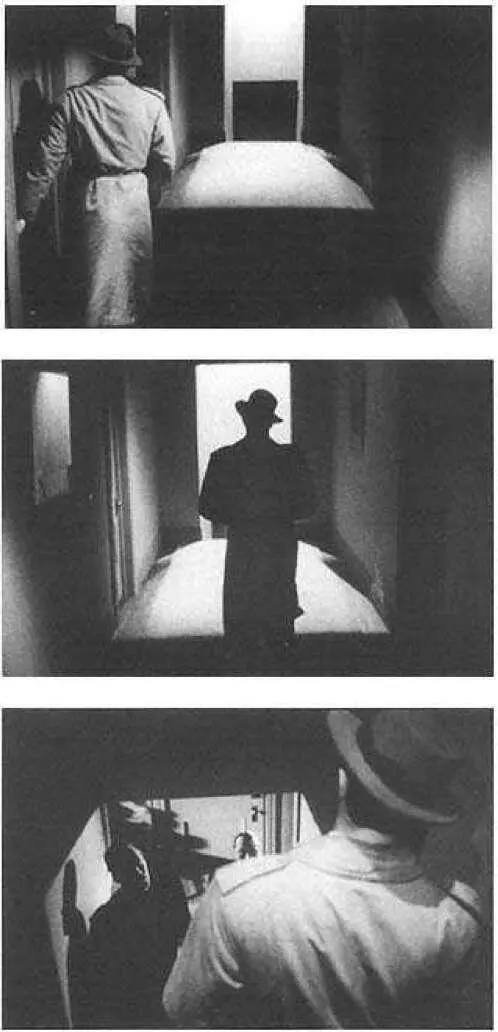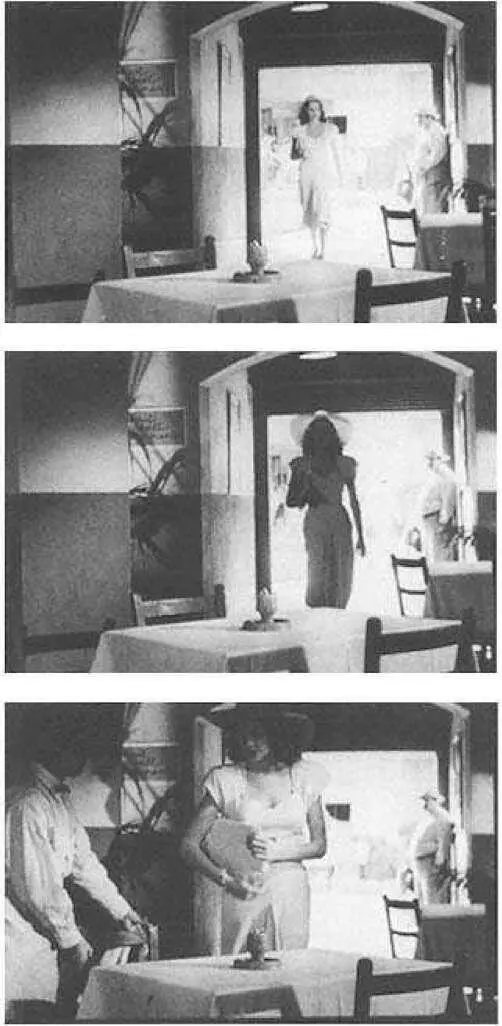Ship-wrecked figures on a raft, in complete darkness, with only the phosphorescence of the ocean waves breaking the ink-black of the pictures; in the distance, the fluctuating light of a lighthouse The effect of passing auto headlights on the ceiling of a dark interior Fluctuating neon or other electric signs The light of a passing streetcar on an otherwise dark street The hanging light on the ceiling of a cheap gambling joint Searchlights of prisons or concentration camps Flashes of guns in absolute darkness
The opening and closing of a refrigerator that has a light inside, in a dark kitchen The well-known street lamp.
(4748)
These and many other hypnotic moments of light-in-darkness were put to excellent use in the medium-budget thrillers that Alton photographed for Anthony Mann during the late 1940s. In Raw Deal (1948), for example, the doomed hero fights with the villain in a firelit room at night and then dies near an alleyway in a slum neighborhood, lying on wet pavement beneath the "well-known street lamp." And in He Walked by Night (1949), a killer is cornered by police in the Los Angeles sewer system, where, as in a similar episode of The Third Man, the only sources of illumination are police searchlights, the "flash of guns in absolute darkness," and "a few photoflood bulbs strategically placed." Such examples might seem commonplace on paper, but both films manage to avoid cliché through the almost tactile quality of the lighting effects; the fog in Raw Deal, for instance, has a glaring, clammy look that makes every other studio-made fog of the period seem fake.
Curiously, Alton's book downplays the techniques of camera perspective, concentrating almost exclusively on codes of glamour and "realism" in the lighting of studio sets and star close-upsthis despite the fact that radical camera angles, wide-angle lenses, and deep-focus compositions were especially important to his "mysterious" pictures. (He was also good at composing eerie, off-center compositions in which an isolated figure is briefly glimpsed at the extreme lower corner of a frame.) Director David Bradley, who came to Hollywood after filming a series of independently produced literary adaptations (Peer Gynt, Julius Caesar, and Othello), recalls that he and Alton had an especially good working relationship on Talk about a Stranger (1952) because they both believed in Wellesian or baroque uses of low-level cameras and sharp depth of field. 17Nearly all of Alton's black-and-white work with Mann was filled with such techniques: in T-Men, for example, two men hold a conversation over a lampshade, and Alton photographs them from below the lamp, aiming straight upward at their chins and using an extreme wide-angle lens that makes them look grotesquely elongated. From the evidence of his book, however, Alton seems to have regarded studio lighting, not framing or perspective, as his transcendent concern. Perhaps he was always more of a Sternbergian aesthete than a tough guy. Even in a criminal melodrama like Raw Deal, he is especially interested in the "color" or lighting palette of black and white. Consider the opening scenes of that film, in which we see Claire Trevor visiting Dennis O'Keefe in prison: the photographic drama is largely a matter of the subtly graded spectrum of light and dark, ranging from the steely gray exteriors and the purgatorial diffusion of the interior establishing shots to the beautiful close-ups of Trevor, who wears the hint of a black veil, and whose eyes sparkle like diamonds because of a cleverly placed reflector.
A similar preoccupation with the tonal qualities of black-and-white imagery can be found in other celebrated films noirs of the 1940s, most of which are neither starkly realistic nor purely expressionistic. These films usually try to achieve a balance between documentary and art, mixing locations with studio sets and creating an eroticized treatment of underworld settings. Their charm has something to do with the purely graphic qualities of the film stock, but it also depends on subtle variations of light, enhanced by arc lamps and a wide array of new lenses that provide sharpness and resolution. In general, they are films that brilliantly exploit the darkness of cinema, replicating the effect of a projector beam splitting through the gloom of an auditorium; again and again, they remind us that the medium itself originated in shadow play, or in the primitive fascination of hot fire gleaming in cold blackness.
A particularly good example of these effects is RKO's Out of the Past (1947), which derives some of its most captivating moments from the fact that it was produced at a studio where nearly everything was composed of rich, India-ink blacks and silvery highlights. Photographer Nicholas Musuraca and director Jacques Tourneur, who had collaborated on the Val Lewton pictures at that same studio, were especially good at creating a lyrical or sensuous play of shadow, and their considerable talents are evident throughout. Interestingly, Musuraca's work involves no night-for-night scenes, no distorting lenses, no extreme deep-focus compositions, no "choker" close-ups, and very few radical anglesin other words, it manifests almost none of the traits that Place and Peterson claim are essential to the visual atmosphere of film noir. 19The photography of Out of the Past nevertheless seems definitively noirlike, chiefly by virtue of its low-key, deeply romantic "painting with light."
Let me pause here to offer a few illustrations of lighting technique in Out of the Past, because this particular film represents such an impressive use of what had become standard Hollywood procedures. The best place to begin is with the major technical problem that affected Musuraca or any studio photographer who worked in low-key black and white: the need to keep the various objects on the screen from blending into one another. Because of the limited "color spectrum" available to the camera, an actor in a beige trenchcoat standing against a gray wall could almost disappear, and sets looked flat if they contained no contrasting points of illumination. One solution to the problem was to make sure that the foreground and the background were lit differently. Consider the moment when Jeff Bailey (Robert Mitchum) exits the manager's office of the Sterling nightclub, where he has just stolen some papers: first he stands against a dark area outside the door, his body illuminated by an overhead lamp; then he walks down the hallway, silhouetted against a bright background; then he descends the stair, moving past an overhead light just as the wall ahead grows dark (figures 3335). An even more striking example of the same effect can be seen early in the film, when Kathie Moffat (Jane Greer) enters the story. Wearing a pale dress and a matching straw hat, she walks out of the Acapulco sun, moving through a dark archway and into the cool shadows of a cantina. Her light clothing makes her almost invisible on the brilliant plaza, but when she steps into the room she seems to materialize out of brightness, becoming first a silhouette and then a visible figure against a shaded wall (figures 3638).


Contrast lighting in Out of the Past (1947).
The same rules apply whether we are speaking of low-key or high-key scenes, although it should be emphasized that clothing itself can be as important as lamps or reflectors. Notice the "framing" episodes of Out of the Past, which were filmed in the crystal-clear daylight of Lake Tahoe, Nevadaan atmosphere that seems more appropriate to a western than to a thriller. When gangster Joe Stephano (Paul Valentine) enters this world, he wears a black hat and a black trenchcoat. Late in the movie, when he drives into the mountains and attempts to kill Jeff Bailey, he is silhouetted against the sunny landscape or against the sparkling waters of a mountain stream. To borrow a line from Raymond Chandler, he looks as conspicuous as a tarantula on a slice of angel food.
Читать дальше














